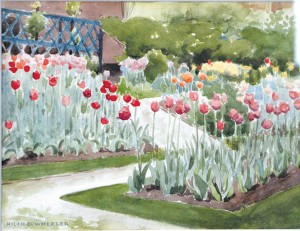The flower beds of Irvington’s earliest gardeners where planted in stiff geometrical shapes including stars, crescents and triangles. For example, the bed in the front yard of Laura Giddings Julian’s (1839-84), home at 115 South Audubon Road, was in the shape of a huge star. It was the pride of the family and often times an attraction to cows which in early Irvington seemed to have “free passage” to roam.
The flower beds of Rachael Johnson (c 1827-99) and Martha Julian (1817-88), both wives of Irvington’s founders, were also geometric forms and were planted in many of the popular flowers of the day including geraniums, verbenas, cigar plants, touch-me-nots, fuchsias, heliotropes, and tuberoses.
Rachael’s husband, Irvington co-founder, Sylvester Johnson (1822-1915), once remarked “All my life I have had a fondness for gardening.” He was noted for his cultivation of fruit trees. strawberries, and grapes on the grounds of their home on the southwest corner of Audubon Road and East Washington. Besides his grape vines, Johnson grew pumpkins (if you want to believe a tall tale) about the size of a cow and weighing as much as a man). Outsized claims aside, many were large enough to take to the State Fair and often times displayed in the front windows of Irvington’s stores.
Jennie Forsyth Jefferies (1853-1932) came to Irvington from Trafalgar, Indiana, in the late 1880s and built her home at 5329 University Ave.. A tulip enthusiast, her garden contained 5,000 tulips and was on two occasions the grand prize winner in Indianapolis beautification contests. Her son-in-law, Robert Hall (1865-1942) also had a fondness for tulips in his garden at 129 South Downey Ave..
Mrs. Lulu Hughel (1868-1963), 5348 Ohmer Ave., was perhaps Irvington’s most enthusiastic, gardener. Hughel, who began “to dig in the dirt” after her children had grown, served as president of the first Irvington Garden Club which was organized on April 13, 1931 and also the president of the Garden Club of Indiana. In addition to 4,000 tulips and 250 cultivars of iris in her garden she favored “rockeries” or rock gardens and often times introduced alpine plants — dianthus, bellflowers, creeping phlox, etc. — suitable for these gardens to the state. Hughel’s garden often times received plant specimens from United States Department of Agriculture’s (USDA’s) Bureau of Plant Industry which she evaluated for their performance. She was a proponent of “Victory or Liberty” gardens during World War II. Her efforts, along with that of others, lead to not only many home gardens but also gardens in large spaces around Irvington, including the old Butler University campus, nine and one-half acres extending from Fletcher to Hoyt Avenues between Irvington and Butler Avenues, and the 17 acres now occupied by Irvington Plaza.
Note: This article was researched by Steve Barnett, Executive Director of The Irvington Historical Society.
Ed Myers is an Advanced Master Gardener and a past president of the Irvington Garden Club and the Garfield Park Master Gardener Association. He is also the Steward of both the Benton House Historic and Kile Oak Habitat Gardens. He may be reached by EMyers3670@aol.com



